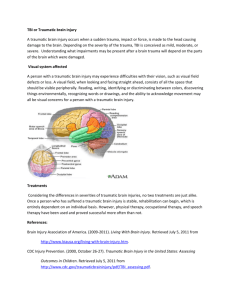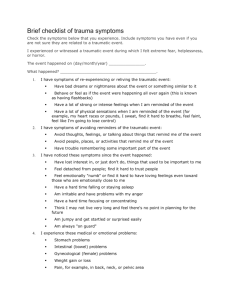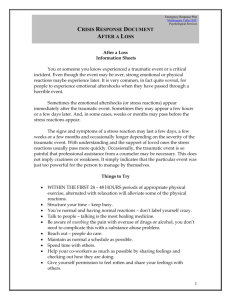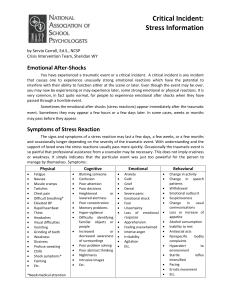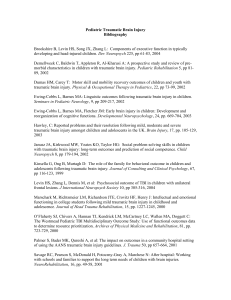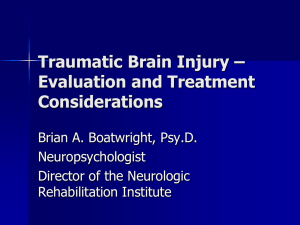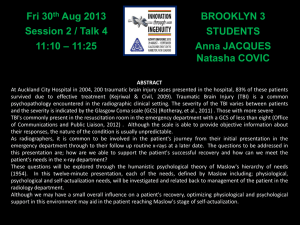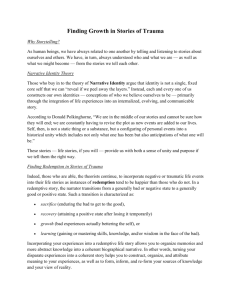Brain Injury Resource Center
advertisement
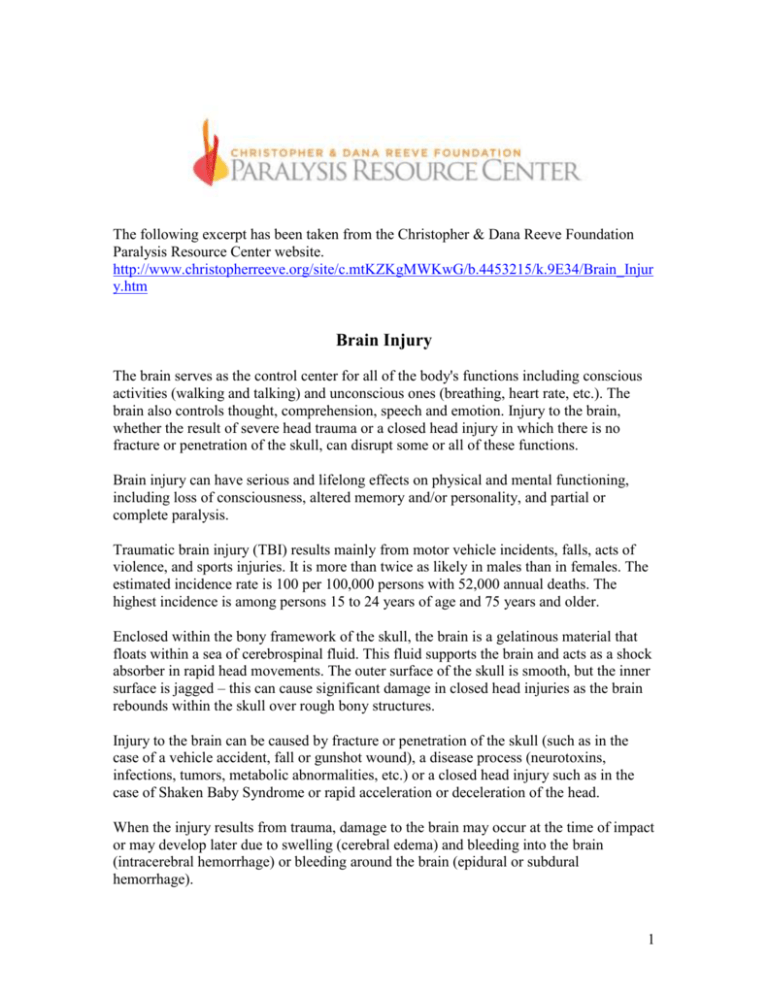
The following excerpt has been taken from the Christopher & Dana Reeve Foundation Paralysis Resource Center website. http://www.christopherreeve.org/site/c.mtKZKgMWKwG/b.4453215/k.9E34/Brain_Injur y.htm Brain Injury The brain serves as the control center for all of the body's functions including conscious activities (walking and talking) and unconscious ones (breathing, heart rate, etc.). The brain also controls thought, comprehension, speech and emotion. Injury to the brain, whether the result of severe head trauma or a closed head injury in which there is no fracture or penetration of the skull, can disrupt some or all of these functions. Brain injury can have serious and lifelong effects on physical and mental functioning, including loss of consciousness, altered memory and/or personality, and partial or complete paralysis. Traumatic brain injury (TBI) results mainly from motor vehicle incidents, falls, acts of violence, and sports injuries. It is more than twice as likely in males than in females. The estimated incidence rate is 100 per 100,000 persons with 52,000 annual deaths. The highest incidence is among persons 15 to 24 years of age and 75 years and older. Enclosed within the bony framework of the skull, the brain is a gelatinous material that floats within a sea of cerebrospinal fluid. This fluid supports the brain and acts as a shock absorber in rapid head movements. The outer surface of the skull is smooth, but the inner surface is jagged – this can cause significant damage in closed head injuries as the brain rebounds within the skull over rough bony structures. Injury to the brain can be caused by fracture or penetration of the skull (such as in the case of a vehicle accident, fall or gunshot wound), a disease process (neurotoxins, infections, tumors, metabolic abnormalities, etc.) or a closed head injury such as in the case of Shaken Baby Syndrome or rapid acceleration or deceleration of the head. When the injury results from trauma, damage to the brain may occur at the time of impact or may develop later due to swelling (cerebral edema) and bleeding into the brain (intracerebral hemorrhage) or bleeding around the brain (epidural or subdural hemorrhage). 1 When the head is hit with sufficient force, the brain turns and twists on its axis (the brain stem), interrupting normal nerve pathways and causing a loss of consciousness. If this unconsciousness persists over a long period of time, the injured person is considered to be in a coma, a condition caused by the disruption of the nerve fibers going from the brain stem to the cortex. A closed head injury often occurs without leaving obvious external signs but the difference between closed and penetrating injuries can be profound. In a bullet wound to the head, for example, a large area of the brain may be destroyed but the result may be minor if that area was not a critical one. In contrast, closed head injuries often result in more widespread damage and extensive neurologic deficits, including partial to complete paralysis, cognitive, behavioral, and memory dysfunction, persistent vegetative state, and death. Injured brain tissue can recover over a short period of time. However, once brain tissue is dead or destroyed, there is no evidence that new brain cells can regrow. The process of recovery usually continues even though new cells do not grow, perhaps as other parts of the brain take over the function of the destroyed tissue. The rehabilitation process begins immediately. Once memory begins to be restored, the rate of recovery often increases. However, many problems may persist, including those related to movement, memory, attention, complex thinking, speech and language, and behavioral changes. Beyond the obvious physical effects of brain injury, survivors frequently cope with depression, anxiety, loss of self-esteem, altered personality, and in some cases, a lack of self-awareness by the injury survivor of any existing deficits. Sources: Institute of Neurological Disorders and Stroke. Websites http://www.tbindsc.org The Traumatic Brain Injury Model Systems National Data and Statistical Center (TBINDSC) TBINDSC, located at Craig Hospital in Englewood, Colorado, is a central resource for researchers and data collectors within the Traumatic Brain Injury Model Systems (TBIMS) program. The primary purpose of the TBINDSC is to advance medical rehabilitation by increasing the rigor and efficiency of scientific efforts to longitudinally assess the experience of individuals with traumatic brain injury (TBI). The TBINDSC provides technical assistance, training, and methodological consultation to 16 TBIMS centers as they collect and analyze longitudinal data from people with TBI in their communities, and as they conduct research toward evidence-based TBI rehabilitation interventions. 2 http://www.msktc.org/tbi/findms.asp#modelsystems Model Systems Knowledge Translation Center: TBI Model Systems Centers This page lists contact information for the 16 model TBI facilities in the U.S. http://www.americanbraincoalition.org American Brain Coalition The American Brain Coalition, a non-profit organization, seeks to advance the understanding of the functions of the brain, and to reduce the burden of brain disorders through public advocacy for increased support of research that will lead to better treatment; services and support that will improve patients’ quality of life; as well as a national commitment towards finding cures for individuals with disabling neurological and psychiatric disorders. http://www.bafound.org The Brain Aneurysm Foundation 269 Hanover Street, Building 3 Hanover, MA 02339 Phone: 781-826-5556, 888-272-4602 E-mail: office@bafound.org The Brain Aneurysm Foundation is the nation’s only nonprofit organization solely dedicated to providing critical awareness, education, support and research funding to reduce the incidence of brain aneurysms. http://www.brainandspinalcord.org/ Brain and Spinal Cord Injuries Phone: 877-216-6020 (Toll-free) This site was created and sponsored by the Newsome Law Firm as a knowledge-base for brain injury and spinal cord injury survivors to help answer questions involving a wide spectrum of issues: health, rehabilitation, hope for recovery, current research, financial, legal, and more. The site includes blogs, in-depth articles, links to resources, and commentary on developments in research and recovery. There is also a video library with basic information that survivors need to know about and videos of other brain injury and spinal cord injury survivors and their families talking about lessons they have learned and telling their personal stories about hope and coping. http://www.biausa.org Brain Injury Association of America (BIAA) 1608 Spring Hill Road, Suite 110 Vienna, VA 22182 Phone: 703-761-0750 National Brain Injury Information Center: 800-444-6443 (Toll-free) BIAA is dedicated to increasing access to quality health care and raising awareness and understanding of brain injury through advocacy, education and research. The organization provides help, hope and healing for individuals who live with brain injury, 3 their families and the professionals who serve them through a nationwide network of state affiliates, local chapters and support groups. https://secure.biausa.org/OnlineDirectory/Pdf/SelectingRehabServices.pdf BIAA: A Guide to Selecting and Monitoring Brain Injury Rehabilitation Services This guide provides recommendations to help people choose a rehabilitation program that meets the needs of the person with brain injury and his/her family. http://free.braininjurypartners.com/ Brain Injury Partners: Navigating the School System This program is designed to give parents of school-aged children with a brain injury the skills they need to become successful advocates. http://www.headinjury.com/ Brain Injury Resource Center P.O. Box 84151 Seattle, WA 98124-5451 Phone: 206-621-8558 E-mail: brain@headinjury.com The Brain Injury Resource Center is a non-profit clearinghouse founded and operated by head injury activists. The site provides information on brain injury and the impairments caused by it, as well as resources and support for dealing with it. http://www.headinjury.com/doctorfind.htm Brain Injury Resource Center: Doctor Finder Checklist This checklist, which includes questions to ask doctors about their expertise and treatments, is designed to help people find a doctor who meets their needs. http://www.headinjury.com/rehabfind2.htm Brain Injury Resource Center: Rehab Finder Checklist This checklist designed to help people collect and analyze information on programs and treatments for brain injury rehabilitation. http://www.braincenter.org Braincenter.org This site has find information about how the brain works, the causes of brain injuries, and how to help a family member recover from a brain injury. http://remind.org/ Bob Woodruff Foundation/ReMIND P.O. Box 955 Bristow, VA 20136 E-mail: info@ReMIND.org 4 The Bob Woodruff Foundation provides resources and support to injured service members, veterans and their families and programs that serve them. Special emphasis is placed on the "hidden signature injuries" of the wars in Iraq and Afghanistan – traumatic brain injury (TBI) and combat stress injuries including post-traumatic stress disorder (PTSD). http://www.dvbic.org Defense and Veterans Brain Injury Center (DVBIC) National Headquarters 11300 Rockville Pike, Suite 1100 Rockville, MD 20852 Phone: 866-966-1020 (Toll-free 24/7 information & referral) DVBIC provides active duty military, their beneficiaries, and veterans with traumatic brain injuries (TBIs) with state-of-the-art clinical care, innovative clinical research initiatives and educational programs through ongoing collaboration with military, VA and civilian health partners, local communities, families and individuals with TBI. There are 15 DVBIC locations at military medical centers, VA hospitals and civilian partners in 11 states and one in Germany. http://www.disaboom.com/traumatic-brain-injury-tbi/ Disaboom: Traumatic Brain Injury This page has links to articles related to traumatic brain injury. http://www.internationalbrain.org International Brain Injury Association (IBIA) IBIA is dedicated to the development and support of multidisciplinary medical and clinical professionals, advocates, policy makers, consumers and others who work to improve outcomes and opportunities for persons with brain injury. http://www.nashia.org National Association of State Head Injury Administrators (NASHIA) NASHIA assists state governments in promoting partnerships and building systems to meet the needs of individuals with brain injury and their families. http://www.dontshake.org/ National Center on Shaken Baby Syndrome 1433 North Highway 89, Suite 110 Farmington, UT 84025 Phone: 801-447-9360 E-mail: mail@dontshake.org The National Center on Shaken Baby Syndrome has a mission to prevent shaken baby syndrome through the development and implementation of education, programs, public policy and research; to establish networks, support and train families, caregivers and professionals. http://www.ninds.nih.gov/disorders/tbi/tbi.htm 5 National Institute on Neurological Disorders and Stroke: Traumatic Brain Injury Information Page This page has information on traumatic brain injury including treatment, prognosis, and research as well as links to publications and related organizations. http://www.neurolaw.com Neurolaw Neurolaw is a field of law dedicated to brain injury and spinal cord injury cases, dealing with issues related to the cause of the injury, the medical necessity or appropriateness of certain medical and rehabilitative treatments, and the impact on the lives of the survivor and family. This site presented by the Fick & May law firm has resources and information to help people understand the legal issues involved in brain and spinal cord injury cases and to find legal assistance. http://www.nabis.org/ North American Brain Injury Society P.O. Box 1804 Alexandria, VA 22313 703-960-6500 (Alexandria), 713-526-6900 (Houston) NABIS is a society comprised of professional members involved in the care or issues surrounding brain injury including clinical care, research, policy and litigation. http://www.tbi.org/ The Perspectives Network E-mail: tpn@tbi.org The Perspectives Network’s primary focus is positive communication between persons with brain injury, family members/caregivers/friends of persons with brain injury, those many professionals who treat persons with brain injury and community members in order to create positive changes and enhance public awareness and knowledge of acquired/traumatic brain injury. http://www.scvmed.org/ Santa Clara Valley Medical Center 751 S. Bascom Avenue San Jose, CA 95128 Phone: 408-885-5000, 408-971-4068 (TTY) Information on the Rehabilitation TBI program can be found by clicking on “Rehabilitation Services” (under Programs & Services) and then “Traumatic Brain Injury”. http://www.myvitalconnections.org/webmanualspreview.nsf/3478d43e5c5c8dcb85256ae 60061f897/0b161e36310251d085256b4200534084!OpenDocument Shepherd Center Learning Connections: Brain Injury Course This online course for patients and their families includes information on the brain, brain injury, cognitive issues associated with brain injury. There are also activities that can help people. 6 http://www.sfn.org Society for Neuroscience 1121 14th Street, NW, Suite 1010 Washington, DC 20005 Phone: 202-962-4000 E-mail: info@sfn.org SFN advances the understanding of brain research by providing information to neuroscientists, the public, and to legislators. http://www.tbirecoverycenter.org Traumatic Brain Injuries This site has information on traumatic brain injuries, including signs and symptoms, care, complications, recovery and research. http://ponce.inter.edu/cai/bv/FedGd_ChFourteen.pdf Where to Turn...Your Guide to Federal Disability Policies & Programs. Brain Injury Association of America and the U.S. Department of Health and Human Services, Health Resources and Services Administration, Maternal and Child Health Bureau. This 2001 guide has information and resources related to assistive technology. Kits Heads Up: Concussion in High School Sports: Free Info for Coaches. Centers for Disease Control, February 2005. Includes video, fact sheets, posters, wallet card, and CDROM. The following books and videos are available for free loan from the PRC library. For more information, please see www.paralysis.org and click Borrow from Our Lending Library under PRC Quick Links. Books Abrahamson, Patt with Jeffery Abrahamson. Brain Injury: A Family Tragedy. Houston, TX: HDI Publishers, 1997. Acorn, Sonia and Penny Offer. Living With Brain Injury: A Guide for Families and Caregivers. Toronto: University of Toronto Press, 1998. Aloni, Ronit and Shlomo Katz. Sexual Difficulties After Traumatic Brain Injury and Ways to Deal With It. Springfield, IL: Charles C. Thomas Publisher Ltd., 2003. 7 Bauser, Nancy. Acceptance Groups for Survivors: A Guide for Facilitators. 1st Books, 2000. Bellenir, Karen. Brain Disorders Sourcebook. Detroit, MI: Omnigraphics, Inc., 1999. Biagioni, Janelle Breese. A Change of Mind: One Family’s Journey Through Brain Injury. Wake Forest, NC: Lash & Associates Publishing/Training Inc., 2004. Brain Injury Association of America. National Directory of Brain Injury Rehabilitation Services. Alexandria, VA: Brain Injury Association of America, 1998. May 2003-2004 edition. Includes CD-ROM. Brain Injury Association of New Jersey. Brain Injury: When the Call Comes— A Congregational Resource. Edison, NJ: Brain Injury Association of NJ, 2005. Brennan, Karen. Being With Rachel. New York: W.W. Norton & Company, 2002. Brown, Alice L. Amazing Lady: There Is Life After Brain Injury. Baltimore: PublishAmerica, 2002. Brown was injured in a fall from her horse and fights to resume her career as a schoolteacher. Bryant, Beverley. In Search of Wings. South Paris, ME: Wings, 1992. Autobiography Bryant, Beverley. To Wherever Oceans Go. South Paris, ME: Wings, 1996. Calderwood, Lynsey. Cracked: Recovering After Traumatic Brain Injury. London: Jessica Kingsley Publishers, 2003. Autobiography Camp, Dora. Brainstorming: Life After Acquired Brain Injury. Fort Bragg, CA: Cypress House, 2005. Cantu, Robert C. Neurologic Athletic Head and Spine Injuries. Philadelphia: W. B. Saunders Company, 2000. Carey, Kevin D. Transcending: An Artist’s Journey Back From Traumatic Brain Injury. Enyon, PA: Avventura Press, 2006. Cicala, Roger S. The Brain Disorders Sourcebook. Los Angeles: Lowell House, 1999. 8 Climbing the Mountain: Stories of Hope and Healing After Stroke and Brain Injury. Candis Fancher, Lindsey McDivitt, and Jacquelyn B. Fletcher, editors. Minneapolis: Fairview Press, 2008. Cohen, Lainie. Crooked Smile: One Family’s Journey Toward Healing. Toronto: ECW Press, 2003. Coskie, Dixie Fremont-Smith. Unthinkable: A Mother’s Tragedy, Terror and Triumph Through a Child’s Traumatic Brain Injury: A Caregiver’s Companion. Deadwood, OR: Wyatt-MacKenzie Publising, 2010. Cramer, Jody. An Excellent Life: One Family’s Experience with Traumatic Injury. Bloomington, IN: AuthorHouse, 2006. Foreward by James Brady. Cramer’s son Michael was injured in an auto accident at the age of 22. Crimmins, Cathy. Where Is the Mango Princess? A Journey Back From Brain Injury. New York: Vintage Books, 2000. A wife’s story after her husband endures brain injury. Cromer, Janet M. Professor Cromer Learns to Read: A Couple’s New Life After Brain Injury. Bloomington, IN: AuthorHouse, 2010. Cromer writes of her husband Alan’s heart attack and cardiac arrest on an airplane that left him with brain damage. Alan lost the ability to talk, read, write, remember, walk, and think. After a while, he regained those abilities to varying degrees. Davies, Patricia. Starting Again: Early Rehabilitation After Traumatic Brain Injury or Other Severe Brain Lesion. New York: Springer-Verlag, 1994. DeBoskey, Dana S. Coming Home: A Discharge Manual for Families of Persons with a Brain Injury. Houston, TX: HDI Publishers, 1996. Del Buono, Barbara. Acknowledged a Man: Survivor of Assault in the YMCA. Watertown, CT: Ellingswood Press, 1998. Dell Orto, Arthur E. and Paul W. Power. Brain Injury and the Family. Boca Raton, FL: CRC Press LLC., 2000. DePompei, Roberta. All About Me! My Life as a Teenager. Wake Forest, NC: Lash & Associates Publishing, 2000. A notebook for students to fill in to prompt their memory about things like the name of their school and teachers. Denton, Gail L. Brainlash: Maximize Your Recovery From Mild Brain Injury. New York: Demos Health, 2008. 9 Written by a psychotherapist who is a brain injury survivor. Dolen, Carolyn E. Brain Injury Rewiring for Loved Ones: A Lifeline to New Connections. Enumclaw, WA: Idyll Arbor, 2010. Dolen, Carolyn E. Brain Injury Rewiring for Survivors: A Lifeline to New Connections. Enumclaw, WA: Idyll Arbor, 2010. Driscoll, Patricia P. and Celia Straus. Hidden Battles on Unseen Fronts: Stories of American Soldiers with Traumatic Brain Injury and PTSD. Philadelphia: CaseMate, 2009. Esherick, Joan. The Journey Toward Recovery: Youth with Brain Injury. (Youth with Special Needs series). Broomall, PA: Mason Crest Publishers, 2004. Written for children and teens. Fairclough, Philip L. Living with Brain Injury. Philadelphia: Jessica Kingsley Publishers, 2002. A brain injury survivor. Freeman, E.A. Brain Injury & Stroke: A Handbook to Recovery. Australia: Hale & Iremonger, 1998. Glang, Ann. Ph.D., McKay Moore Sohlberg. Ph.D. and Bonnie Todis. Ph.D. Compensatory Systems: For Students with Brain Injuries. Wake Forest, NC: L&A Publishing / Training, 1999. Gosling, Geo. TBI Hell: A Traumatic Brain Injury Really Sucks. Denver, CO: Outskirts Press, 2006. Biography Grace, Stephen. Under Cottonwoods: A Novel of Friendship, Fly Fishing and Redemption. Guilford, CT: Lyons Press, 2003. Fiction about a friendship between a brain-injured man and a man in the community who takes him fly fishing and camping. Gronwall, D., P. Wrightson, and P. Waddell. Head Injury: The Facts. New York: Oxford University Press, 1990. Guide to Traumatic Brain Injury Resources Produced by NIDRR Grantees. National Center for the Dissemination of Disability Research: Austin, TX, 2002. Hernandez, Maria Antonia. Silent Screams: Stories of Traumatic Brain Injuries. Xlibris Corporation, 2002. 10 Hughes, Kathy with Rita Milios. God Isn’t Finished with Me Yet! St. Louis, MO: Hardbound, Inc., 1990. Jameson, Larry and Beth Jameson. Brain Injury Survivor’s Guide: Welcome to Our World. Denver, CO: Outskirts Press, 2008. Jandial, Rahul. 100 Questions & Answers About Head and Brain Injuries. Sudbury, MA: Jones and Bartlett Publishers, 2009. Johns, Amber J. Our Journey with Joshua. Bloomington, IN: AuthorHouse, 2005. Biography written by Joshua’s sister documenting his recovery from TBI. Lancaster, Steven Kirk. Life After a Head Injury. Bloomington, IN: AuthorHouse, 2005. Biography Landau, Elaine. Head and Brain Injuries. Berkeley Heights, NJ: Enslow Publishers, 2002. Lawhorne, Cheryl and Don Philpott. Combat-Related Traumatic Brain Injury and PTSD: A Resource and Recovery Guide. Lanham, MD: Government Institutes, 2010. Lash, Marilyn. When a Parent Has a Brain Injury: Sons and Daughters Speak Out. Worcester, MA: Massachusetts Head Injury Association, 1993. Lerner, Heidi. Gray Matters: Brain Injury – The Inside Perspective. Bloomington, IN: AuthorHouse, 2006. Poetry with pictures of brain injured people. Includes a glossary and appendix on brain injury. Lewis, Simon. Rise and Shine: The Extraordinary Story of One Man’s Journey from Near Death to Full Recovery. Santa Monica, CA: Santa Monica Press, 2010. Long, PJ. Gifts From the Broken Jar: Rediscovering Hope, Beauty, and Joy. Culver City, CA. EquiLibrium Press, 2005. Lund, Diana. Remind Me Why I’m Here. New York: iUniverse, 2006. Marion, Donald. Traumatic Brain Injury. New York: Thieme Medical Publishers, 1999. 11 Martin-Urban, Judy and Courtney Martin Larson. I Can’t Remember Me: Recovery After Traumatic Brain Injury. Austin, TX: LangMarc Publishing, 2006. Mason, Douglas J. The Mild Traumatic Brain Injury Workbook. Oakland, CA: New Harbinger Publications, 2004. Mason, Jill C. Couldn’t Happen to Me: A Life Changed by Paralysis and Traumatic Brain Injury. Booksurge, 2009. Injured in 2004 by a drunk driver while riding her bike in preparation for a triathlon, then 26-year old Jill Mason began the battle back from death while struggling with TBI and paraplegia. Mason, Michael Paul. Head Cases: Stories of Brain Injury and Its Aftermath. New York: Farrar, Straus and Giroux, 2008. McNeil, Noelle. Heaven Exists. Denver, CO: Outskirts Press, 2009. McNeil was thrown from a horse and suffered a brain injury. She is now a motivational speaker and shares her story. Mogerman, Sol. Objects in Mirror Are Closer Than They Appear. Lincoln, NE: People With Disabilities Press, 2001. Personal story of accident and recovery. Morningstar, Louise Ray with Alexia Dorszynski. Journey Through Brain Trauma: A Mother’s Story of Her Daughter’s Recovery. Dallas: Taylor Publishing, 1997. O’Connor-Barnett, Linda. I Can’t Cry in Colors. 1st Books Library, 2002. Osborn, Claudia L. Over My Head. Kansas City, KS: Andrews McMeel Publishing, 1998. A doctor’s personal story of head injury. Papas, Pam. New Normals--Reclaiming a Life of Significance: A Guide for Caregivers, Families & Survivors of Stroke/Brain Injury. Hanover, PA: Papas Press, 2009. Parker, James N. and Philip M. Parker. The Official Patient’s Sourcebook on Traumatic Brain Injury. San Diego, CA: ICON Health Publications, 2003. A revised and updated directory for the Internet age. Pettit, Kevin. Rambling Down Life’s Road…With a Brain Injury. Xlibris, 2003. 12 Physical Therapy for Traumatic Brain Injury. Jacqueline Montgomery, editor. New York: Churchill Livingstone, 1995. Prowe, Garry. Successfully Surviving a Brain Injury: A Family Guidebook, From the Emergency Room to Selecting a Rehabilitation Facility. Gainesville, FL: Brain Injury Success Books, 2010. Quinn, Deborah A. Conquering the Darkness: One Woman’s Story of Recovering from a Brain Injury. St. Paul, MN: Paragon House, 1998. Autobiography. Rehabilitation for Traumatic Brain Injury. Walter M. High, Jr., editor. New York: Oxford University Press, 2005. Reinhardt, Floyd Edward. You’re Ok, Kid!: The Search for a Father’s Love. Littleton, CO: Littleton Publishing Company, 2004. Richmond, Beverly June. View from the Bedpan. Ontario, Canada: Epic Press, 2002. Autobiography focusing on the healing process. Rocchio, Carolyn. Ketchup on the Baseboard: Rebuilding Life After Brain Injury. Wake Forest, NC: Lash & Associates Publishing/Training, 2004. Rosenthal, Mitchell, Ernest Griffith, Jeffrey Kreutzer and Brian Pentland. Rehabilitation of the Adult and Child With Traumatic Brain Injury. Philadelphia: F.A. Davis Company, 1999. Savage, Ron. Ed.D. The Child’s Brain: Injury and Development. Wake Forest, NC: Lash & Associates Publishing / Training, 1999. Senelick, Richard C. and Cathy E. Ryan. Living With Brain Injury. Birmingham, AL: HealthSouth Press, 1998. Senelick, Richard C. and Karla Dougherty. Living With Brain Injury. Birmingham, AL: HealthSouth Press, 2001. Shulman, Alix Kates. To Love What Is: A Marriage Transformed. New York: Farrar, Straus and Giroux, 2008. Shulman’s husband sustained a brain injury. Siles, Madonna. Brain, Heal Thyself: A Caregiver’s New Approach to Recovery from Stroke, Aneurysm, and Traumatic Brain Injuries. Charlottesville, VA: Hampton Roads Publishing, 2006. 13 Silver, Jonathan M., Thomas W. McAllister and Stuart C. Yudofsky. Textbook of Traumatic Brain Injury. Washington, D.C.: American Psychiatric Publishing, 2005. Snyder, Heather. Elvin, the Elephant Who Forgets. Wolfeboro, NH: L&A Publishing, 1998. Sohlberg, McKay Moore, Ph.D., Bonnie Todis, Ph.D., Ann Glang, Ph.D. and Marilyn Lash, M.S.W. Brain Injury: Causes & Consequences for Students. Wake Forest, NC: L&A Publishing / Training, 1999. Sohlberg, McKay Moore, Ph.D., Bonnie Todis, Ph.D. and Ann Glang, Ph.D. Changes in Self Awareness: Among Students with Brain Injuries. Wake Forest, NC: L&A Publishing / Training, 1999. Children’s fiction about an elephant with a brain injury. Stein, Donald G., Simon Brailowsky and Bruno Will. Brain Repair. New York: Oxford University Press, 1995. Stoler, Diane Roberts and Barbara Albers Hill. Coping With Mild Traumatic Brain Injury. New York: Avery, 1998. Dr. Stoler is living proof of an undiagnosed condition and its ability to forever change your life. Strand, Mike. Meditations on Brain Injury. Zottola Publishing, 2003. Stumbo, Janet A. Endless Journey. Santa Ana, CA: OEP Foundation, 1998. A doctor endures a head-trauma and her incredible rehabilitation. Sullivan, Cheryle. Brain Injury Survival Kit: 365 Tips, Tools, & Tricks to Deal with Cognitive Function Loss. New York: Demos Medical Publishing, 2008. Swanson, Kara L. I’ll Carry the Fork! Los Altos, CA: Rising Star Press, 1999. Swiercinsky, Dennis P. Normal Again: Redefining Life with Brain Injury. San Jose: Writer’s Showcase, 2002. Thomas, Abigail. A Three Dog Life: A Memoir. New York: Harcourt, 2006. Thomas’ husband, Rich, was brain injured when hit by a car. Tyler, Janet Siantz and Mary P. Mira. Traumatic Brain Injury in Children and Adolescents: A Sourcebook for Teachers and Other School Personnel. Austin, TX: Pro-Ed, 1999. 2nd edition. 14 Uzzell, B.P. and Henry H. Stonnington. Recovery After Traumatic Brain Injury. Mahwah, NJ: Lawerence Erlbaum Associates, 1996. Varney, Nils R. and Richard J. Roberts. The Evaluation and Treatment of Mild Traumatic Brain Injury. Mahwah, NJ: Lawrence Erlbaum Associates, 1999. Walker, Sue and Beth Wicks. Educating Children with Acquired Brain Injury. London: David Fulton Publishers, 2005. Williamson, Keith. Speechless: God and a Brain Injury. Enumclaw, WA: Winepress Publishing, 2005. Autobiography of Williamson who fell while fishing, smashing his head on rocks. Winslade, William J. Confronting Traumatic Brain Injury. New Haven, CT: Yale University Press, 1998. Woo, Buck H. and Shanker Nesathurai. The Rehabilitation of People With Traumatic Brain Injury. Boston: Boston Medical Center, 2000. Woodruff, Lee and Bob. In an Instant: A Family’s Journey of Love and Healing. New York: Random House, 2007. Woodruff, an ABC News Anchor, was brain injured while reporting in Iraq. Also available in audio CD. Wright, Helene. Someone Stole Yesterday. Franklin, TN: Providence House Publishers, 2000. Biography. Videos Advancements in Traumatic Brain Injury. Princeton, NJ: Films for the Humanities and Sciences, 1997. (19 minutes) Acquired Brain Injury: Teens Talking to Teens. Wake Forest, NC: Lash & Associates Publishing/Training. VHS. (25 minutes) Brain Injury Dialogues. 2009. DVD. (52 minutes) www.braininjurydialogues.org Documentary on Rick Franklin’s brain injury. Breakaway…a Tale of Two Survivors. Boston: Fanlight Productions, 2000. (45 minutes) Documentary of one brain injury survivor who is now a caregiver to a more severely injured brain injury survivor. 15 The Critical Link: CHRs and Traumatic Brain Injury in Indian Country. Brain Injury Awareness for Community Health Representatives. Albuquerque, NM: New Mexico Aging & Long-Term Services, 2009. DVD. (35 minutes) Every 21 Seconds: Living with a Brain Injury. Sherborn, MA: Aquarius Health Care Media, 2007. DVD. (60 minutes) 8 stories of brain injury narrated by Woody Harrelson. Title on DVD when played is Every 21 Seconds Or Why I Scream at the Refrigerator. Other title is from box. Every 21 Seconds…Or Why I Scream at the Refrigerator. New Mexico Brain Injury Advisory Council, 2005. 8 stories of brain injury narrated by Woody Harrelson. In Harm’s Way: Traumatic Brain Injury in Young Children. Brain Injury Awareness for Head Start Providers. Albuquerque, NM: New Mexico Aging & Long-Term Services, 2009. DVD. (39 minutes) The Incremental Injury: Living Day to Day with a Brain Injury. Sherborn, MA: Aquarius Health Care Videos, 2004. (29 minutes) The Injured Brain: Closed Head Trauma. Princeton, NJ: Films for the Humanities and Sciences, 1994. VHS and DVD. (19 minutes) Life Goes On: Inside the Lives of Families of Youth with Brain Injuries. Wake Forest, NC: Lash & Associates, 2000. VHS. (30 minutes) Living with Brain Injury: A Guide for Families. Birmingham, AL: HealthSouth Press, 1999. (75 minutes) The Loss of Nameless Things. PBS Home Video, 1008. DVD. (83 minutes) Oakley Hall III, a theater founder, loses his creativity and personality after a fall off a bridge. Peter Wegner Is Alive and Well and Living in Providence. New York: Filmakers Library, 2002. (20 minutes) Programming the Dysfunctional Brain: Discover Options for the Treatment of Cerebral Palsy & Traumatic Brain Injury. Cicero, NY: Program Development Associates, 2000. The Puzzle Club: Brain Injury Survivors Talk and the Making of the Puzzle Club. Cicero, NY: Program Development Associates, 2005. Rebuilding the Brain: Adult Brain Stem Cells. Princeton, NJ: Films for the Humanities and Sciences, 2002. (21 minutes) 16 Regarding Henry. Paramount, 2003. 1991 film. DVD. (107 minutes) Harrison Ford stars as a lawyer who suffers a TBI due to gunshot and must learn to walk, talk and read again. The Silent Epidemic: Mild Traumatic Brain Injury. Part One: Identification & Diagnosis, Part Two: Management of MTBI. Albuquerque, NM: New Mexico Aging & Long-Term Services, 2009. DVD. Understanding Brain Injury: What You Should Know About Brain Injury and Recovery. Atlanta, GA.: Shepherd Center, 2011. DVD. (50 minutes) Produced by the Shepherd Center in collaboration with the American Trauma Society, the Brain Injury Association of America and the Christopher & Dana Reeve Foundation. Visit www.BrainInjury101.org to view the video online and download a copy of the companion booklet. When Billy Broke His Head…and Other Tales of Wonder. Boston: Fanlight Productions, 1994. (56 minutes) “An entertaining and funny film about disability, civil rights, and the search for intelligent life after brain damage.” Wipe Out. National Film Board of Canada, 2008. DVD (51 minutes) Documentary on three young men who became brain injured while pursuing extreme sports. Without Warning: The James Brady Story. HBO Video,1991.(88 minutes) Beau Bridges plays Presidential Press Secretary Brady . The information contained in this message is presented for the purpose of educating and informing you about paralysis and its effects. Nothing contained in this message should be construed nor is intended to be used for medical diagnosis or treatment. It should not be used in place of the advice of your physician or other qualified health care provider. Should you have any health care related questions, please call or see your physician or other qualified health care provider promptly. Always consult with your physician or other qualified health care provider before embarking on a new treatment, diet or fitness program. You should never disregard medical advice or delay in seeking it because of something you have read in this message. 17
